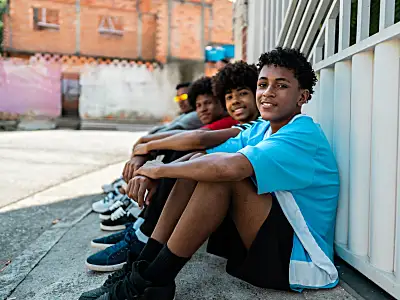Integrated Community Violence Prevention and Intervention Strategies
Firearm violence can be reduced by identifying and mediating individual, social, and structural causes and correlates of firearm violence through community violence prevention strategies. Collaboration among law enforcement, public health organizations, community-based groups, and survivors of violence is important to develop comprehensive approaches to promote resilience for those at risk for firearm violence.
Project Highlights
Effectiveness of Adverse Community Experiences and Resilience (ACER)
With funding from CDC, RTI is examining the Effectiveness of Adverse Community Experiences and Resilience (ACER) and Community Organizing for Preventing Youth Violence and Adverse Childhood Experiences. This project seeks to prevent adverse childhood experiences, including traumatic events that can negatively affect a minor’s physical and behavioral health. RTI will evaluate the effectiveness of the ACER violence prevention framework combined with community organizing in stopping child abuse, neglect, and youth violence in Milwaukee. The ACER project builds on an existing partnership between the Prevention Institute and the Milwaukee Office of Violence Prevention to heal from ongoing community traumas, including incidents of police use of force affecting Black residents. Findings will inform approaches to strengthen community resilience and prevent multiple forms of violence experienced by youth, and RTI will help determine best strategies to disseminate these methods to communities.
The Project Safe Neighborhoods Program
RTI leads the multi-site evaluation to assess the effectiveness of the Project Safe Neighborhoods program. This Department of Justice (DOJ)-sponsored initiative involves cooperation of multiple criminal justice agencies and their partners working at the local level to develop and implement strategic responses to reduce violent crime, with an emphasis on gun crime. Project Safe Neighborhoods is part of DOJ’s comprehensive violent crime reduction strategy.
Evaluating Responses to Calls for Service
Building off of an Arnold Ventures-supported project that focused on understanding and improving responses to calls for service (CFS), RTI is designing an evaluation of programs in three jurisdictions that provide alternative response to low-risk, non-emergency 911 crisis calls for service modeled after the Crisis Helping out on the Streets (CAHOOTS) program in Eugene, Oregon, follow-up care post crisis call, and co-response models with law enforcement. the Eugene, OR CAHOOTS (Crisis Assistance Helping Out On The Streets) program as it is planned for implementation in Burlington, VT; Vallejo, CA; and Durham, NC. The study will include: 1) a process evaluation to assess program implementation and fidelity to the CAHOOTS-model; 2) a quasi-experimental outcome evaluation to determine if responses to eligible calls for service result in reduced negative outcomes (e.g., arrests, citations, use of force) and improved positive outcomes (e.g., referrals and transportation to services); 3) and a cost effectiveness study. The information from this study will provide evidence of the impact of CAHOOTS-like programs on CFS outcomes, and if the program merits further replication.















